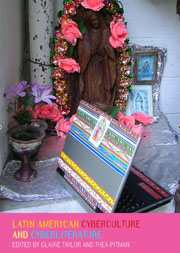Book contents
- Frontmatter
- Contents
- List of Illustrations
- Acknowledgements
- Foreword: Latin American Cyberliterature: From the Lettered City to the Creativity of its Citizens
- Notes on Contributors
- Introduction
- I Cyberculture and Cybercommunities
- 1 The New New Latin American Cinema: Cortometrajes on the Internet
- 2 Cyborgs, Cities, and Celluloid: Memory Machines in Two Latin American Cyborg Films
- 3 The Cyberart of Corpos Informáticos
- 4 Latin American Cyberprotest: Before and After the Zapatistas
- 5 Body, Nation, and Identity: Guillermo Gómez-Peña's Performances on the Web
- 6 Cyberspace Neighbourhood: The Virtual Construction of Capão Redondo
- 7 Literary E-magazines in Latin America: From Textual Criticism to Virtual Communities
- 8 Negotiating a (Border Literary) Community Online en la línea
- II Cyberliterature: Avatars and Aficionados
- A Cyberliterary Afterword: Of Blogs and Other Matters
- Conclusion: Latin American Identity and Cyberspace
- Suggested Further Reading
- Index
2 - Cyborgs, Cities, and Celluloid: Memory Machines in Two Latin American Cyborg Films
from I - Cyberculture and Cybercommunities
- Frontmatter
- Contents
- List of Illustrations
- Acknowledgements
- Foreword: Latin American Cyberliterature: From the Lettered City to the Creativity of its Citizens
- Notes on Contributors
- Introduction
- I Cyberculture and Cybercommunities
- 1 The New New Latin American Cinema: Cortometrajes on the Internet
- 2 Cyborgs, Cities, and Celluloid: Memory Machines in Two Latin American Cyborg Films
- 3 The Cyberart of Corpos Informáticos
- 4 Latin American Cyberprotest: Before and After the Zapatistas
- 5 Body, Nation, and Identity: Guillermo Gómez-Peña's Performances on the Web
- 6 Cyberspace Neighbourhood: The Virtual Construction of Capão Redondo
- 7 Literary E-magazines in Latin America: From Textual Criticism to Virtual Communities
- 8 Negotiating a (Border Literary) Community Online en la línea
- II Cyberliterature: Avatars and Aficionados
- A Cyberliterary Afterword: Of Blogs and Other Matters
- Conclusion: Latin American Identity and Cyberspace
- Suggested Further Reading
- Index
Summary
Introduction
The interdependencies between film and the city have been the object of much critical investigation. Likewise, the lateral connections imposed or encouraged by urban existence have long been coded in terms of the dissolution of boundaries between the human and the machinic, with the city being understood as a technology for moulding the body to the forms of industrial manufacture and consumption. Latterly, the massive emergence of cybernetic cultures has collapsed at its very base the distinction between the sphere of industry – the technological transformation of the material world – and the (ideological) sphere of representations. If representations – in the form of information, styles, and codes – have become the ‘raw material’ on which the cyber economy does its work, and if all transformations of the material world (even and most especially biological processes) can be coded in terms of a problem of information processing, of obtaining the ‘correct’ representation, model, or simulation, then cultural forms such as film, originally an imaginary nexus between the individual and the collective (particularly the city), take on a new and profoundly allegorical character. This is the case, in very different ways, with the two principal Latin American cyborg films I shall be examining here: Guillermo del Toro's Mexican film Cronos of 1993, and Fernando Spiner's Argentine film La sonámbula of 1998.
- Type
- Chapter
- Information
- Latin American Cyberculture and Cyberliterature , pp. 50 - 69Publisher: Liverpool University PressPrint publication year: 2007



